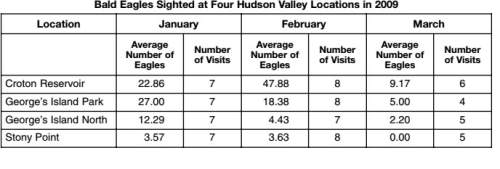"bald eagle facts
•bald eagles eat primarily fish, carrion (dead animals), smaller birds, and...

"bald eagle facts
•bald eagles eat primarily fish, carrion (dead animals), smaller birds, and rodents. their most important non-carrion food is fish, which they catch by swooping down and grabbing fish that are near the surface of the water.
•the number of nesting pairs in the lower 48 united states increased from fewer than 450 in the early 1960s to more than 4,500 adult bald eagle nesting pairs in the 1990s. today, there are an estimated 9,789 nesting pairs of bald eagles.
•bald eagles are found in large numbers in certain areas during the winter (known as roosts). these winter roosts are located in areas where prey are plentiful. winter roosts are protected under federal law, and managed with a buffer zone to reduce human disturbance. as winter ends, the eagles return to their summer nesting/hunting areas.
bald eagle research
in the winter of 2009, volunteers from an audubon group conducted a survey of roosting bald eagles at four locations in an area in the lower hudson river valley. the data below show the average number of eagles sighted and the number of visits made by the volunteers each month. among the other data collected were percent ice cover and percent cloud cover on the surface of the water. the eagles fly freely between these four sites, depending on a variety of conditions.
some of the data are shown in the table below.
state one reason why the number of eagles sighted showed a change at all four sites between february and march"


Answers: 1


Another question on Biology

Biology, 21.06.2019 22:40
Sea levels are rising due to climate change while increasing numbers of people are moving into coastal areas. to accommodate more people, there has been increased construction of beachfront resorts and condominiums. how is this impacting sea turtle numbers and biodiversity and why? a. the increased human population in coastal areas has meant that more food is available to the turtles (e.g., dropped food, waste from restaurants), which has led to an increase in the numbers and diversity of sea turtles. b. there has been very little change in the numbers and biodiversity of sea turtles because the planet is so vast that they can simply relocate to less crowded beaches. c. this has resulted in a decrease in numbers and diversity of sea turtles because it is restricting available nesting sites, and hence reproduction. d. this has resulted in an increase in numbers and diversity of sea turtles because people are around to protect them from natural predators.
Answers: 1

Biology, 22.06.2019 01:30
As a result of wildfires, in grasslands. a) tree growth increases b) grass growth increases c) soil quality decreases d) invertebrate variety decreases
Answers: 2

Biology, 22.06.2019 06:50
The fascicles of the deltoid are ; the fascicles of the pectoralis parallel; bipennate fusiform; unipennate multipennate; triangular bipennate; fusiform
Answers: 3

Biology, 22.06.2019 07:00
What terms describes being out of water after being submerged
Answers: 1
You know the right answer?
Questions



History, 16.10.2020 16:01




Computers and Technology, 16.10.2020 16:01


Mathematics, 16.10.2020 16:01



Mathematics, 16.10.2020 16:01


Arts, 16.10.2020 16:01


Mathematics, 16.10.2020 16:01

Biology, 16.10.2020 16:01

Mathematics, 16.10.2020 16:01




